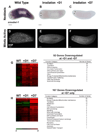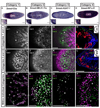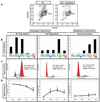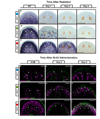Molecular analysis of stem cells and their descendants during cell turnover and regeneration in the planarian Schmidtea mediterranea
- PMID: 18786419
- PMCID: PMC2614339
- DOI: 10.1016/j.stem.2008.07.002
Molecular analysis of stem cells and their descendants during cell turnover and regeneration in the planarian Schmidtea mediterranea
Abstract
In adult planarians, the replacement of cells lost to physiological turnover or injury is sustained by the proliferation and differentiation of stem cells known as neoblasts. Neoblast lineage relationships and the molecular changes that take place during differentiation into the appropriate cell types are poorly understood. Here we report the identification and characterization of a cohort of genes specifically expressed in neoblasts and their descendants. We find that genes with severely downregulated expression after irradiation molecularly define at least three discrete subpopulations of cells. Simultaneous BrdU labeling and in situ hybridization experiments in intact and regenerating animals indicate that these cell subpopulations are related by lineage. Our data demonstrate not only the ability to measure and study the in vivo population dynamics of adult stem cells during tissue homeostasis and regeneration, but also the utility of studies in planarians to broadly inform stem cell biology in adult organisms.
Figures






References
-
- Anderson DJ, Gage FH, Weissman IL. Can stem cells cross lineage boundaries? Nature medicine. 2001;7:393–395. - PubMed
-
- Baguña J. Mitosis in the intact and regenerating planarian Dugesia mediterranea I. Mitotic studies during growth, feeding, and starvation. J Exp Zool. 1976;195:53–64.
-
- Bardeen CR, Baetjer FH. The inhibitive action of the Roentgen rays on regeneration in planarians. J Exp Zool. 1904;1:191–195.
-
- Blanpain C, Lowry WE, Geoghegan A, Polak L, Fuchs E. Self-renewal, multipotency, and the existence of two cell populations within an epithelial stem cell niche. Cell. 2004;118:635–648. - PubMed
Publication types
MeSH terms
Grants and funding
LinkOut - more resources
Full Text Sources
Medical
Molecular Biology Databases

